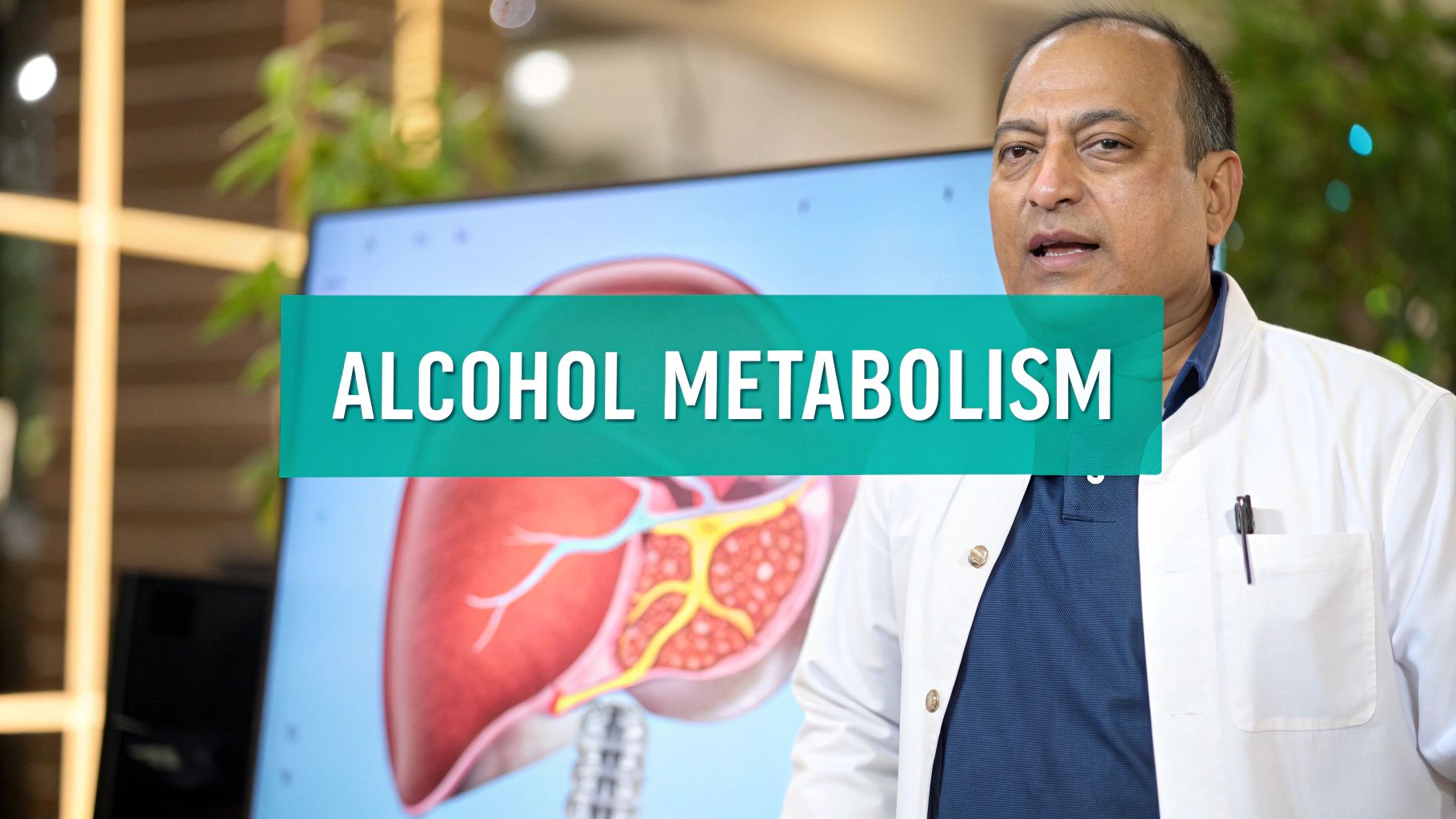

· By Annemarie
Alcohol Metabolism: How Your Body Processes Drinks
The Journey of Alcohol Through Your Body

From your first sip, alcohol begins its journey through your body. The process starts with absorption, mainly in the stomach and small intestine. Think of your bloodstream as a highway system, with alcohol merging into the traffic flow. This happens quickly, often reaching the brain in minutes. This rapid absorption explains why the effects are felt so soon. However, factors like food in your stomach can impact the absorption rate.
Once in your bloodstream, alcohol circulates throughout your body. It interacts with various organs, including the brain, producing the feelings associated with intoxication. The liver, however, plays the crucial role in alcohol metabolism, acting like the body's processing center for ethanol, the type of alcohol in alcoholic beverages. It works to remove the alcohol, preventing it from accumulating and causing harm.
Understanding the Liver’s Role
The liver's role in metabolizing alcohol is essential. This vital organ diligently breaks down ethanol, preventing it from reaching toxic levels. But, the liver has a limited processing capacity. Consuming alcohol faster than your liver can metabolize it causes your blood alcohol concentration (BAC) to increase. This is a key reason why pacing yourself is crucial.
Alcohol metabolism is more than just feeling the effects of a drink; it's a critical detoxification process. The liver processes about 90% of the ethanol consumed. This involves two key enzymes: alcohol dehydrogenase (ADH) and aldehyde dehydrogenase (ALDH). Alcohol dehydrogenase converts ethanol to acetaldehyde, which aldehyde dehydrogenase then transforms into acetate. Acetate then breaks down into carbon dioxide and water.
One standard drink can almost saturate the liver’s metabolic capacity, impacting peak BAC based on individual body weight and composition. In men, the average elimination rate is around 0.015 g/100 mL per hour, roughly equivalent to processing one standard drink hourly. Enzyme efficiency varies between individuals, often due to genetics and ethnicity. Learn more about the pharmacology of ethanol.
The Process of Elimination
After the liver processes the alcohol, the byproducts exit the body primarily through urine and breath. This explains the effectiveness of breathalyzer tests in measuring BAC. Understanding this entire journey—from absorption and distribution to metabolism and elimination—provides insight into how your body handles alcohol and reinforces the importance of responsible consumption.
The Powerhouse Enzymes Behind Alcohol Metabolism

We've discussed alcohol's journey through the body and the liver's essential role. Now, let's dive into the specifics of how alcohol is broken down at the molecular level. This intricate process relies on two key enzymes: alcohol dehydrogenase (ADH) and aldehyde dehydrogenase (ALDH).
Alcohol Dehydrogenase (ADH): The First Responder
ADH is the first enzyme on the scene, initiating the breakdown of alcohol. It converts ethanol, the type of alcohol we consume in beverages, into acetaldehyde. Acetaldehyde is a highly toxic substance. ADH acts like a demolition crew, breaking down the ethanol molecule but leaving behind hazardous material.
This initial conversion is crucial because it sets the stage for the next step in the detoxification process. Without ADH, the body wouldn't be able to effectively process alcohol.
Aldehyde Dehydrogenase (ALDH): The Cleanup Crew
ALDH takes over where ADH leaves off. This enzyme quickly converts the toxic acetaldehyde into acetate, a much less harmful compound. Acetate is then further broken down into carbon dioxide and water, both of which the body easily eliminates.
ALDH acts like a cleanup crew, removing the dangerous byproducts created by ADH. This two-step process is vital to prevent a buildup of acetaldehyde, which can cause significant negative effects.
Genetic Variations and Alcohol Metabolism
The efficiency of these enzymes, ADH and ALDH, differs significantly among individuals. This variation is primarily due to genetic factors. These genetic differences explain why some people experience adverse reactions to alcohol, such as the "Asian flush."
This flushing reaction is caused by a buildup of acetaldehyde due to a less active variant of the ALDH enzyme. This particular variation, ALDH2*2, is more common in people of East Asian descent.
To better illustrate the roles and differences between ADH and ALDH, let's take a look at the following table:
Comparison of Alcohol Metabolizing Enzymes: This table compares the two main enzymes involved in alcohol metabolism, showing their roles, products, and genetic variations.
| Enzyme | Primary Function | Converts | Into | Genetic Variations | Effects of Variations |
|---|---|---|---|---|---|
| Alcohol Dehydrogenase (ADH) | Initiates alcohol breakdown | Ethanol | Acetaldehyde | Several variants exist affecting enzyme activity | Affects rate of alcohol metabolism and acetaldehyde production |
| Aldehyde Dehydrogenase (ALDH) | Converts toxic acetaldehyde | Acetaldehyde | Acetate | Variants like ALDH2*2 decrease enzyme activity | Acetaldehyde buildup, causing flushing, nausea, and other unpleasant effects |
As shown in the table, while both enzymes play crucial roles in alcohol metabolism, they act on different substances and have different genetic variations that can impact their effectiveness.
The Impact of Enzyme Efficiency
The varying activity levels of ADH and ALDH significantly influence how quickly the body processes alcohol. Individuals with highly active ADH and less active ALDH might experience rapid intoxication but also a faster accumulation of toxic acetaldehyde. Conversely, those with less active ADH may metabolize alcohol more slowly, resulting in a prolonged feeling of intoxication.
Understanding these differences underscores the importance of being aware of your own body's response to alcohol. This knowledge can empower individuals to make more informed choices about alcohol consumption.
Why Your Body Processes Alcohol Differently Than Others

Have you ever noticed how some friends seem perfectly fine after a couple of drinks, while others are noticeably affected after just one? This isn't a trick of the mind. The way our bodies process alcohol is influenced by a fascinating combination of biological, genetic, and even lifestyle factors. Understanding these factors can help you better understand your own body's response to alcohol.
Biological Factors at Play
Several key biological differences contribute to varying alcohol metabolism rates. Body composition, for example, plays a significant role. Alcohol distributes primarily in lean tissue. This means individuals with a higher percentage of body fat tend to have higher alcohol concentrations in their bloodstream, leading to a more pronounced effect.
Sex is another important biological factor. Women generally have less body water and lower activity of the enzyme alcohol dehydrogenase (ADH) than men. This difference results in women typically reaching higher blood alcohol content (BAC) levels with less alcohol, and feeling the effects more quickly.
The Role of Genetics
Our genetic makeup also plays a crucial role in how we metabolize alcohol. The specific versions of enzymes we inherit partially determine the rate at which our bodies process and eliminate alcohol. This explains why some individuals are more sensitive to alcohol's effects or experience side effects like facial flushing.
Even something as simple as eating can affect alcohol absorption. Consuming food before or while drinking can slow absorption, leading to lower peak BAC levels. Furthermore, genetic variations in enzymes like ADH and ALDH influence alcohol metabolism across different populations. To learn more about the science behind alcohol metabolism, visit the Bowling Green State University's Wellness Connection.
Lifestyle and Behavioral Choices
Beyond our biology and genes, lifestyle choices also have a significant impact. Medication interactions are a key concern. Some medications can amplify the effects of alcohol, leading to increased intoxication, while others can create dangerous interactions. Always consult your doctor or pharmacist about potential interactions between medications and alcohol.
Hydration also plays a vital role. Being dehydrated can concentrate alcohol in the bloodstream, intensifying its effects. Staying well-hydrated, on the other hand, can help lessen some of the negative impacts. Even your circadian rhythm may influence alcohol metabolism, with some research suggesting variations in processing depending on the time of day.
To help summarize the impact these different factors can have, let's take a look at this table:
Factors Influencing Alcohol Metabolism Rates
This table presents various factors that impact how quickly alcohol is processed in the body and their relative effects.
| Factor | Impact on Metabolism Rate | Explanation | Practical Implication |
|---|---|---|---|
| Body Composition | Higher fat, slower rate | Alcohol distributes primarily in lean tissue, leading to higher BAC in individuals with higher body fat percentages. | Individuals with more body fat may experience stronger effects from the same amount of alcohol. |
| Sex | Slower rate in women | Women generally have less body water and lower ADH activity. | Women typically reach higher BAC levels with less alcohol. |
| Genetics | Variable | Inherited enzyme variations influence metabolism speed. | Some individuals may be more susceptible to alcohol's effects or experience side effects like flushing. |
| Food Consumption | Slower rate | Food slows alcohol absorption. | Eating before or while drinking can reduce peak BAC levels. |
| Hydration | Dehydration increases rate | Dehydration concentrates alcohol in the blood. | Staying hydrated can mitigate some of the negative impacts of alcohol. |
| Medication | Variable | Certain medications can interact with alcohol, either enhancing or inhibiting its effects. | Consult with a doctor about potential medication interactions with alcohol. |
| Circadian Rhythm | Variable | Research suggests alcohol may be processed differently depending on the time of day. | Alcohol consumption at different times of day may lead to varying effects. |
As you can see, many different factors can play a significant role in how quickly your body can process alcohol. Understanding these factors can help you make responsible decisions about alcohol consumption.
Understanding Your Unique Profile
Alcohol metabolism is a highly individual process. All the factors discussed above work together to create a unique profile for each person. As women age, hormonal changes during perimenopause can also influence how their bodies process alcohol, making them more sensitive to its effects. Understanding these factors empowers you to make more informed choices about alcohol consumption.
Decoding BAC: The Science of Intoxication Levels

We've explored how individual factors influence alcohol processing. Now, let's dive into the science behind intoxication levels, measured by Blood Alcohol Concentration (BAC). Understanding BAC is key for responsible alcohol consumption.
What Is BAC and How Is It Measured?
BAC is a percentage reflecting the amount of alcohol in your bloodstream. A BAC of 0.08% means 0.08 grams of alcohol are present in every 100 milliliters of blood. This measurement is the standard for legal intoxication in many areas.
BAC is typically measured through breathalyzer tests, blood tests, or urine tests. Breathalyzers are the most common method used by law enforcement, offering a quick, non-invasive estimation of BAC.
Understanding the BAC Curve
The relationship between alcohol consumption and BAC isn't a straight line. Your BAC continues rising even after you stop drinking, as your body absorbs the alcohol. This is the BAC curve.
The peak of this curve, representing your highest BAC, can occur a while after your last drink. Factors like the amount and type of alcohol, food intake, and individual metabolism affect the curve's shape.
BAC and Its Effects
Different BAC levels correspond to specific physical and cognitive effects. At lower levels, like 0.02%, you might feel a little relaxed.
As your BAC climbs, the effects intensify. At 0.05%, impaired judgment and coordination become noticeable. At the legal limit of 0.08%, significant impairment affects reaction time, decision-making, and motor control. Even higher BAC levels can lead to severe impairment, loss of consciousness, and even life-threatening alcohol poisoning.
Legal Limits and Variations
While 0.08% is a common legal limit for driving, it varies globally. Some countries have stricter limits, reflecting a zero-tolerance stance on drinking and driving.
These variations highlight the seriousness of impaired driving and the importance of understanding local legal implications. Regardless of the limit, any amount of alcohol can impair driving ability.
Factors Influencing BAC
Several factors influence how quickly your BAC rises and falls. Your rate of alcohol metabolism, affected by genetics, age, and sex, plays a significant role.
Women generally metabolize alcohol slower than men, resulting in higher BACs with the same alcohol intake. Eating before or during drinking slows absorption, reducing how quickly your BAC rises.
Estimating Your BAC
While only a breathalyzer or blood test accurately measures BAC, online calculators can estimate your BAC based on your drinking habits, factoring in weight, sex, and number of drinks.
However, these are estimations and shouldn't guide decisions about driving or operating machinery. As women age, hormonal shifts during perimenopause can further influence alcohol metabolism and impact BAC. This life stage can bring other health concerns that alcohol can affect. Gut health also plays a role in alcohol metabolism. For more information, explore this gut health guide. Understanding your body's response to alcohol and how it affects your BAC is vital for making responsible choices and ensuring your safety and well-being. Remember, even after you stop drinking, your BAC can continue to rise, so pacing yourself and knowing your limits are essential.
How Alcohol Metabolism Impacts Your Overall Health
Alcohol's journey through your body involves much more than just the initial feeling of intoxication. The way your body processes alcohol, or its metabolism, can have a significant impact on various aspects of your health, both in the short term and long term. Let's delve into how this process influences everything from hangovers to more serious health risks.
The Role of Acetaldehyde
As we know, alcohol metabolism involves the conversion of ethanol to acetaldehyde, a toxic chemical compound. The enzyme aldehyde dehydrogenase (ALDH) usually processes acetaldehyde quickly. However, even temporary buildups can have negative consequences. Acetaldehyde is considered a primary culprit in hangover symptoms such as headaches, nausea, and vomiting.
Moreover, regular heavy drinking can result in prolonged exposure to acetaldehyde, raising concerns about long-term health problems. This increased exposure is linked to a heightened risk of certain cancers, liver damage, and cardiovascular issues.
Liver Adaptation and Damage
Your liver is the main organ responsible for metabolizing alcohol. It adapts to regular alcohol consumption, often by increasing enzyme production to process alcohol more efficiently. However, this adaptation can eventually become harmful. Continued exposure to high levels of alcohol can overload the liver, potentially leading to fatty liver disease, alcoholic hepatitis, and ultimately, cirrhosis.
Impact on Medication and Nutrients
Alcohol metabolism can also interact with how your body processes medications. This interaction may either increase or decrease the effectiveness of certain drugs. It’s always vital to discuss potential interactions with your doctor or pharmacist. Additionally, alcohol affects the absorption of essential nutrients, especially B vitamins like thiamine, crucial for nerve function and overall health.
Alcohol’s Effect on Sleep
Beyond its physical effects, alcohol disrupts your sleep. While it might initially cause drowsiness, it interferes with the restorative stages of sleep. This leaves you feeling tired and groggy even after a full night's sleep. This disruption can negatively impact your mood, cognitive function, and general well-being.
Hormonal Influences and Age
Hormonal changes, particularly in women during perimenopause, can also influence alcohol metabolism. The decrease in estrogen levels during this time can potentially increase sensitivity to alcohol, leading to more noticeable effects. These changes may also worsen other perimenopausal symptoms, like hot flashes, night sweats, and mood swings.
Alcohol and Long-Term Health Risks
Understanding how your body processes alcohol is crucial for recognizing its potential long-term effects. Chronic alcohol abuse significantly strains the liver and other organs, increasing the risk of developing severe health conditions. These can range from cardiovascular problems and certain cancers to neurological damage and mental health issues.
The connection between alcohol metabolism and your overall health is complex and multifaceted. By being aware of the effects of acetaldehyde, liver adaptation, medication interactions, nutrient absorption, and sleep disruption, you can make more informed choices about your alcohol consumption and prioritize your well-being. Moderation is key. Drinking responsibly can help minimize potential risks and contribute to a healthier and more balanced lifestyle.
Sobering Truth: Myths vs. Science of Processing Alcohol
Can you really speed up alcohol metabolism with coffee, cold showers, or exercise? Many myths surround "sobering up," but the science tells a different story. This section separates fact from fiction, exploring popular methods and revealing the truth about which ones work (spoiler: very few).
Debunking Common Myths
Let's address some persistent myths about speeding up alcohol metabolism:
-
Coffee: While caffeine might make you feel more alert, it doesn't speed up alcohol metabolism. It can mask the sedative effects of alcohol, leading to riskier behavior as individuals underestimate their intoxication.
-
Cold Showers: A cold shower might shock your system, but it won't affect your BAC (Blood Alcohol Content). Your body processes alcohol at a fixed rate, regardless of temperature. The health of your gut can impact alcohol metabolism. See this helpful resource on gut health.
-
Exercise: Physical activity won't accelerate alcohol processing. While it might seem invigorating, it won't eliminate alcohol from your system any faster and could even be dangerous due to impaired coordination and judgment.
-
Eating a Big Meal: Eating before or during drinking can slow alcohol absorption, but it doesn't impact the metabolic rate once the alcohol enters your bloodstream.
The Truth About Time
The most important factor in alcohol metabolism is time. Your body processes alcohol at a relatively constant rate, typically around one standard drink per hour for men. This rate can be influenced by individual factors like genetics, body composition, and liver health, but there are no quick fixes.
This consistent rate is due to the limited capacity of the enzymes responsible for breaking down alcohol. Your liver works to process the alcohol, but it can only handle so much at once.
What Actually Helps with Hangovers?
While there's no magic cure for preventing hangovers, some strategies can help mitigate their effects:
-
Hydration: Drinking plenty of water, both while consuming alcohol and afterward, helps prevent dehydration, a significant contributor to hangover symptoms.
-
Proper Rest: Alcohol disrupts sleep, so getting adequate rest after drinking can help your body recover.
-
Nutrient-Rich Foods: Eating a balanced meal before or during drinking can slow alcohol absorption and provide essential nutrients.
Responsible Drinking Practices
The most effective way to avoid the negative consequences of alcohol is to practice responsible drinking:
-
Pace Yourself: Avoid consuming alcohol faster than your body can metabolize it.
-
Know Your Limits: Understand how alcohol affects you personally and stick to a consumption level that allows you to remain in control.
-
Plan Ahead: If you plan to drink, arrange for safe transportation or a designated driver.
-
Stay Hydrated: Drink plenty of water throughout the night and the following day.
Understanding the science of alcohol metabolism is crucial for making informed decisions about alcohol consumption. Avoid relying on myths and instead focus on responsible practices. Ready to enjoy your night out without the worry of a hangover? Try Upside Hangover Sticks, a convenient and effective way to support your body after drinking. Visit https://enjoyupside.com to learn more and order yours today!
